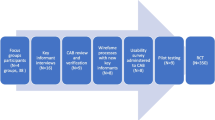Abstract
Limited data and research is available on the health issues faced by the South Asian population, especially for those living in the Washington, DC metropolitan area. Online and in-person surveys were administered to a convenience sample (n = 709) of South Asians living in the metropolitan Washington DC region. The survey gathered information on socio-demographics and acculturation; health care access and utilization; sources of health information; perceptions of community health; physical activity and smoking. While over 70 % of participants had a routine physical exam in the last 12 months, foreign born and less acculturated adults were less likely to have had a routine visit in the last 12 months. Internet (76.9 %) and physicians (76.1 %) are key sources of health information for South Asians. Only 29 % of South Asians are engaging in the recommended amount of physical activity per week. The results of this study provide guidance for future work in addressing the health and well-being of South Asian communities in the United States.

Similar content being viewed by others
References
The US Census Bureau. The Asian Population: 2000. Census 2000 Brief [online]. http://www.census.gov/prod/2002pubs/c2kbr01-16.pdf. Accessed 7 April 2010.
The World Bank. South Asian: Countries [online].http://web.worldbank.org/WBSITE/EXTERNAL/COUNTRIES/SOUTHASIAEXT/0,,menuPK:158850~pagePK:146748~piPK:146812~theSitePK:223547,00.html. Accessed 7 April 2010.
South Asian Public Health Association. A Brown Paper: The Health of South Asians in the United States, SAPHA. 2002.
South Asian Americans Leading Together, Health Care Issues Affecting South Asians in the United States, Online Report (2009). Takoma Park, MD.
Leonard K. The South Asian Americans. 1st ed. Westport: Greenwood Press; 1997.
Corward H., Hinnels JR. & Brady Williams R, editors. The South Asian Religious Diaspora in Britain, Canada, and the United States. 1st ed. Albany, NY: State University of New York Press; 2000.
Bhattacharya G, Schoppelrey SL. Preimmigration beliefs of life success, postimmigration experiences, and acculturative stress: South Asian immigrants in the United States. J Immigrant Health. 2004;6(2):83–92.
U.S. Department of Homeland Security. Characteristics of Specialty Occupation Workers (H-1B): Fiscal Year 2002 [online]. http://shusterman.com/pdf/h1b-903.pdf. Accessed 7 April 2010.
Tirodkhar MA, Baker DW, Makoul GT, Khurana N, Paracha MW, Kandula NR. Explanatory models of health and disease among south asian immigrants in Chicago. J Immigr Minority Health. 2010;13(2):385–94.
Harding S. Mortality of migrants from the Indian subcontinent to england and wales: effect of duration of residence. Epidemiology. 2003;14:287–92.
Venkat Narayan KM, Aviles-Santa L, Oza-Frank R, Pandey M, Curb JD, McNeely M, Araneta MR, Palaniappan L, Rajpathak S, Barett-Conner E. Report of national heart, lung, and blood institute workshop: heterogeniety in cardiometabolic risk in Asian Americans in the US. J Am Coll Cardiol. 2010;55:966–73.
Ramaraj R, Chellappa P. Cardiovascular risk in South Asians. Postgrad Med J. 2008;84(996):518–23.
Joshi P, Islam S, Pais P, Reddy S, Dorairaj P, Kazmi K, et al. Risk factors for early myocardial infarction in South Asians compared with individuals in other countries. J Med Assoc. 2007;297(3):286–94.
Enas EA. How to beat the heart disease epidemic among South Asians: a prevention and management guide for Asian Indians and their doctors. Downers Grove.
Ebas EA, Garg A, Davidson MA, Nair VM, Huet BA, Yusuf S. Coronary heart disease and its risk factors in first-generation immigrant Asian Indians to the United States of America. Indian Heart J. 1996;48:343–53.
Mohan V, Vijachandrika V, Gokulakrishnan K, Anjana RM, Ganesan A, Weber MB, Narayan KM. AIC cut points to define various glucose intolerance groups in Asian-Indians. Diabetes Care. 2010;33:515–9.
Chowdhury T, Grace C, Kopleman PG. Preventing diabetes in south asians: too little action and too late. Bri Med J. 2003;327(7423):1059–60.
Kanaya AM, Wessel CL, Mathur D, Stewart A, Herrington D, Budoff MJ, Ranpura V, Liu K. Prevalence and correlates in diabetes in South Asian Indians in the United States: findings from the metabolic syndrome and atherosclerosis in South Asians living in America and multi-ethnic study of atherosclerosis studies. Metab Syndr Relat Disord. 2010;2:157–64.
Kanaya A, Mathur D, Ranpura V, Byri S, Wassel C. South Asians and diabetes: higher risk with traditional beliefs. 2008.
Duffey KJ, Gorden-Larsen P, Ayala GX, Popkin BM. Birthplace is associated with more adverse dietary profiles for US-born than for foreign-born Latino adults. J Nutr. 2008;138(12):2428–35.
Kalra P, Srinivasan S, Ivey S, Greenlund K. Knowledge and practice: the risk of cardiovascular disease among Asian Indians. Results from focus groups conducted in Asian Indian communities in Northern California. Ethn Dis. 2004;14(4):497–504.
Reeves T, Bennet C. We the people: Asian Americans in the United States. Accessed US Census Bureau 7 May 2010 http://www.census.gov/prod/2004pubs/censr-17.pdf. Issued December 2004.
Centers for Disease Control and Prevention. Office of Surveillance, Epidemiology, and Laboratory Services Behavioral Risk Factor Surveillance System. Historical questions. http://apps.nccd.cdc.gov/BRFSSQuest/ListByYear.asp?Yr=2009&Submit=Go.
Acknowledgments
The authors gratefully acknowledge the assistance of Karishma Anand, Subha Chandar, Swetha Desai, Sweta Dharia, Librada Estrada, Kristen Kappos, Elizabeth Leonard, Yesha Malik, Sapna Pandya, Nausheen Saeed, Arati Trivedi, Avani Patel, Rakhi Patel, Nrupa Jani, Sumitha Nagarajan, Prathima Parthasarathi, Dr. Manasi Tirodkar, Dr. Ushma Upadhyay and Marisa Schnider. We appreciate the support and cooperation of local community and faith-based organizations, and we are incredibly grateful to all the community members who participated in this project.
Author information
Authors and Affiliations
Corresponding author
Rights and permissions
About this article
Cite this article
Vyas, A.N., Chaudhary, N., Ramiah, K. et al. Addressing a Growing Community’s Health Needs: Project SAHNA (South Asian Health Needs Assessment). J Immigrant Minority Health 15, 577–583 (2013). https://doi.org/10.1007/s10903-012-9655-x
Published:
Issue Date:
DOI: https://doi.org/10.1007/s10903-012-9655-x



